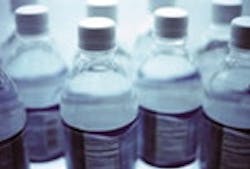International Bottled Water Association Releases Statement on Polycarbonate Bottles
The International Bottled Water Association has released a position statement regarding the safety of polycarbonate bottles and the presence of bisphenol A (BPA).
Polycarbonate plastic is used in a wide variety of consumer products, including food and drink containers. Many 3- and 5-gal bottled water containers are made of polycarbonate plastic, and “consumers can remain confident about the safety of these products,” IBWA said.
Bottled water is comprehensively regulated as a food product by the U.S. Food and Drug Administration (FDA). Plastic food and beverage containers, including polycarbonate plastic made with BPA, must meet or exceed all FDA requirements. The FDA clears all food-contact plastics for their intended use based on migration and safety data. The clearance process includes stringent requirements for estimating the levels at which such materials may transfer to the diet. The FDA's safety criteria require extensive toxicity testing for any substance that may be ingested at more than negligible levels. The statement points out that this means the FDA has affirmatively determined that, when cleared plastics are used as intended in food-contact applications, the nature and amount of substances that may migrate, if any, are safe.
Many studies have been conducted to assess the potential for trace levels of BPA to migrate from polycarbonate bottles into foods or beverages. The conclusions from those studies and comprehensive safety evaluations by government bodies worldwide are that polycarbonate bottles are safe for consumer use, the IBWA statement said.
On Oct. 28, 2008, FDA issued a statement in response to a report by an FDA Science Board Subcommittee, which raised questions regarding FDA’s safety assessment concerning BPA. FDA agreed that more research “would be valuable” and the agency is “moving forward” with additional planned studies.
FDA’s statement reaffirmed the agency’s position regarding the safety of BPA. They stated: “Consumers should know that based upon all available evidence, the present consensus among regulatory agencies in the United States, Canada, Europe and Japan is that current levels of exposure to BPA through food packaging do not pose an immediate health risk to the general population, including infants and babies.”
The National Toxicology Program released its final report on the potential human reproductive and developmental effects of bisphenol A on Sept. 3, 2008. From a wide variety of possible adverse health effects that were considered, the NTP has only some concern for effects on the brain, behavior and prostate gland in fetuses, infants and children at current human expo¬sures to bisphenol A. This means that NTP believes that more research is needed in this area, which IBWA supports.
A publication by Yale University claims to have linked BPA to problems with brain function and mood disorders in monkeys. The American Chemistry Council responded to the Yale study in a statement, saying “there is no direct evidence that exposure to bisphenol A adversely affects human reproduction or development.” On Sept. 17, 2008, Lang et al. published in the Journal of the American Medical Association an epidemiological study linking an increased presence of bisphenol A in the blood of humans to an increase in diabetes and certain cardiovascular diseases. While epidemiological research can provide insights into the occurrence of diseases, it can never establish a causal relationship, the IBWA statement said, meaning this study does not demonstrate that bisphenol A was the cause of any of the reported effects.
Germany’s Federal Institute for Risk Assessment (BFR, the German equivalent to the FDA) evaluated the relevance of both the Yale and JAMA studies and concluded that the results published in these reports do not question the current risk assessment of bisphenol A in food. Moreover, The European Food Safety Authority (EFSA) released a statement on Oct. 22, 2008, concerning the JAMA study that concluded that there is no sufficient proof for a causal link between exposure to BPA and the health conditions mentioned in the article. For more information on this issue, visit the FDA’s website at www.fda.gov/oc/opacom/hottopics/bpa.html.
Source: IBWA
